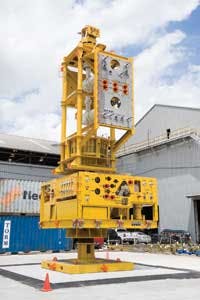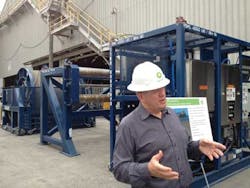Emergency subsea well control response more than a capping stack
As part of the 2013 Offshore Technology Conference, BP held a press tour of its Houston deepwater emergency subsea response base. This is where the BP-owned equipment is stored unless needed to respond to a loss of well control at the seabed anywhere in the world.
There is much more to emergency response of this type than is first apparent.
The 15,000 psi capping stack, with its upper and lower parts, is the centerpiece of the operation and its most visible element. The rest of the story is the other equipment and planning steps required to make it work, and the challenge of getting it all onto location anywhere in the world.
On the equipment side, BP stocks rows of adapters to fit every deepwater drilling rig the company contracts to mate to either the lower marine riser package or, if the LMRP is not in place, atop the BOP. There also are the hydraulic tools and equipment required to actuate the valves on the stack. Other pieces of the kit provide dispersant into the wellstream, equipment to clear the area of damage and obstructive hardware in place before the accident, boxes of ROV tools to operate everything, and a subsea hydraulic power unit to keep it all working.
And yet, all this preparation and engineering expertise can be rendered unavailable for myriad logistics reasons.
Geir Karlsen, BP's containment response team leader, explained how the giant equipment can be stymied by a piece of paper, and what BP is doing to avoid that possibility.
Logistics is the issue. To get all the hardware on location, BP practices regional planning exercises. Among the planning elements are such details as customs clearance paperwork, the availability of a number of aircraft capable of carrying the weight, the capacity of the destination airport to handle those planes, the issues of offloading the materials, the availability of trucks that can carry the pieces, capacities of roadways and bridges to bear the weight and size, etc.
While there is any number of Boeing 747 cargo airplanes available, the equipment has to be lifted into the transport. This limits each equipment load to whatever lifting capacity is available at the airport at the time. The Antonov 124 cargo plane is the preferred vehicle because it can be loaded by ramp rather than by lift. Plus, it has the greatest carrying capacity of any airplane commercially available. That's the good news. The bad news is that there are a limited number of them and they may not be available when needed.
Even if available, the destination can affect the load capacity. While the Antonov 124 may be able to carry 110 metric tons (121 tons) of cargo, there is a maximum landing weight in Brazil, for instance, of 85 metric tons (93.7 tons).
The order of shipping starts as an open question, too. Until an ROV inspection of the seabed site has been done, the exact equipment needed is not known. To try to counter this possible delay, BP has prioritized the equipment for shipping. An ROV, for instance, might be among the high priority items while a flow-back assembly might be on the lowest priority list. In that way, the company can begin responding before all the details of the specific problem are defined.
All of this time, technology, planning, and personnel go into preparing for something that nobody wants to see happen.
That's the oil business for you.
OneSubsea makes debut
The newly minted joint venture of Cameron and Schlumberger, OneSubsea, made its maiden voyage into the OTC last month. The joint venture is designed to manufacture and develop products, systems, and services for the subsea oil and gas market. Further, it will target improved recovery through integration and optimization of the production system over the life of a field from reservoir and downhole technology to subsea production equipment.
Cameron and Schlumberger have 60/40 ownership of the joint venture, respectively.
Cameron is contributing its existing subsea division and will get $600 million from Schlumberger. Schlumberger will contribute its Framo, Surveillance, Flow Assurance, and Power and Controls businesses. Cameron will manage the joint venture and will consolidate it for financial reporting.
OneSubsea says it will be able to provide real-time measurements of the reservoir and production profile using data transmission to and from the well site and management locations. This continuous data flow is designed to help optimize flow to maximize recovery.
It also makes possible informed communication among the disciplines involved in the oil field, from the geologist to the drilling engineer to the production manager.



